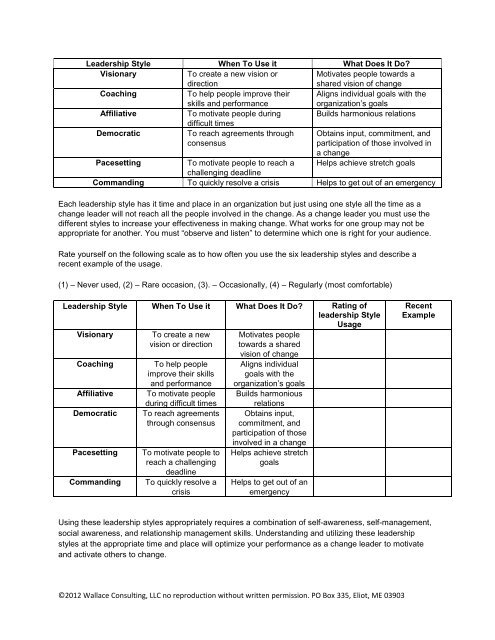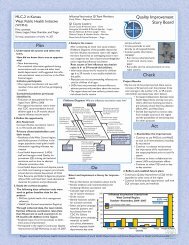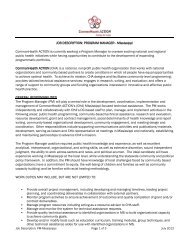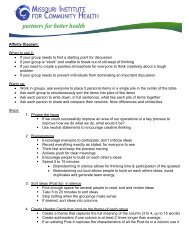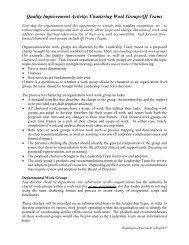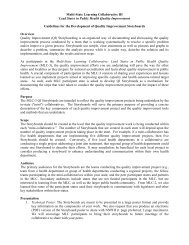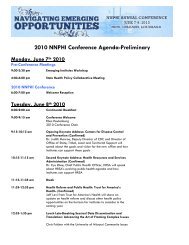Understanding Your Leadership Style - Public Health Foundation
Understanding Your Leadership Style - Public Health Foundation
Understanding Your Leadership Style - Public Health Foundation
You also want an ePaper? Increase the reach of your titles
YUMPU automatically turns print PDFs into web optimized ePapers that Google loves.
<strong>Leadership</strong> <strong>Style</strong> When To Use it What Does It Do?<br />
Visionary<br />
To create a new vision or<br />
direction<br />
Motivates people towards a<br />
shared vision of change<br />
Coaching<br />
To help people improve their<br />
skills and performance<br />
Aligns individual goals with the<br />
organization’s goals<br />
Affiliative<br />
To motivate people during Builds harmonious relations<br />
difficult times<br />
Democratic<br />
To reach agreements through<br />
consensus<br />
Obtains input, commitment, and<br />
participation of those involved in<br />
a change<br />
Pacesetting<br />
To motivate people to reach a Helps achieve stretch goals<br />
challenging deadline<br />
Commanding To quickly resolve a crisis Helps to get out of an emergency<br />
Each leadership style has it time and place in an organization but just using one style all the time as a<br />
change leader will not reach all the people involved in the change. As a change leader you must use the<br />
different styles to increase your effectiveness in making change. What works for one group may not be<br />
appropriate for another. You must “observe and listen” to determine which one is right for your audience.<br />
Rate yourself on the following scale as to how often you use the six leadership styles and describe a<br />
recent example of the usage.<br />
(1) – Never used, (2) – Rare occasion, (3). – Occasionally, (4) – Regularly (most comfortable)<br />
<strong>Leadership</strong> <strong>Style</strong> When To Use it What Does It Do? Rating of<br />
leadership <strong>Style</strong><br />
Usage<br />
Visionary<br />
Coaching<br />
Affiliative<br />
Democratic<br />
Pacesetting<br />
Commanding<br />
To create a new<br />
vision or direction<br />
To help people<br />
improve their skills<br />
and performance<br />
To motivate people<br />
during difficult times<br />
To reach agreements<br />
through consensus<br />
To motivate people to<br />
reach a challenging<br />
deadline<br />
To quickly resolve a<br />
crisis<br />
Motivates people<br />
towards a shared<br />
vision of change<br />
Aligns individual<br />
goals with the<br />
organization’s goals<br />
Builds harmonious<br />
relations<br />
Obtains input,<br />
commitment, and<br />
participation of those<br />
involved in a change<br />
Helps achieve stretch<br />
goals<br />
Helps to get out of an<br />
emergency<br />
Recent<br />
Example<br />
Using these leadership styles appropriately requires a combination of self-awareness, self-management,<br />
social awareness, and relationship management skills. <strong>Understanding</strong> and utilizing these leadership<br />
styles at the appropriate time and place will optimize your performance as a change leader to motivate<br />
and activate others to change.<br />
©2012 Wallace Consulting, LLC no reproduction without written permission. PO Box 335, Eliot, ME 03903


